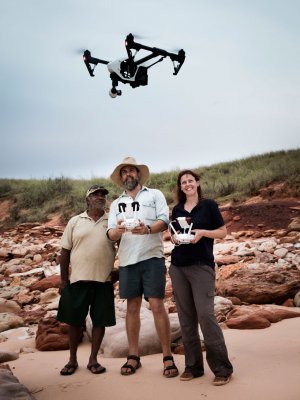
University of Queensland palaeontologists are using the latest scientific technology to capture new information that will help bring a 130-million-year-old dinosaur landscape back to life.
School of Biological Sciences Senior Lecturer Dr Steve Salisbury and his team have returned from a dinosaur hunt along the ‘Dinosaur Coast’ in the remote Kimberley region of Western Australia.
Palaeontologist and dinosaur track expert Dr Anthony Romilio said the team was documenting fossilised dinosaur tracks in an effort to learn more about what sorts of dinosaurs inhabited Australia 130 million years ago.
“The sandstone that the tracks occur in crops out in the intertidal zone, at sites scattered along roughly 100 km of coastline,” he said.
“Because of the extreme tides in this part of Australia, the rock platforms we’re working on are exposed for only a short window each day, and sometimes for only a few days each year.
“This means we have to work very quickly, before the tracks go underwater.
“We take physical moulds of tracks using a rapid-setting silicon rubber which can then be used to produce rigid plastic replicas back at UQ.
“We also take overlapping sets of high-resolution photographs of individual tracks and entire rock platforms, which we later convert into 3D digital models.”
The project uses the latest mapping technology, including a remote-controlled aerial drone, a hand-held laser-scanner developed by CSIRO, and a specially equipped remote-sensing survey plane.
Dr Salisbury said the project included low-tech equipment as well.
“A lot of our work involves preparing the track sites for photography and scanning. This means lots of scrubbing to remove sand and water,” he said.
“Despite recent National Heritage Listing of the Dampier Peninsula’s dinosaur tracks, many of the tracks remain largely undocumented, and their full scientific significance is poorly understood.
“The results of this project should allow us to construct high-resolution, 3D digital outcrop models of the track sites, and bring the 130 million-year-old landscapes back to life.”
The three-year Australian Research Council-funded Discovery Project is being conducted in partnership with Associate Professor Jorg Hacker (Airborne Research Australia, Flinders University), Dr Mike Bosse (Autonomous Systems Lab, ETH Zurich), Dr Robert Zlot (Autonomous Systems Lab, CSIRO), and George Poropat (Mine Environment Imaging, CSIRO).
The team also works closely with Goolarabooloo Traditional Custodians and Yawuru Native Title holders, as the dinosaur tracks form an important part of a song cycle that extends along the coastline.
The group returned from their latest expedition on 24 April and are now analysing and documenting their field-trip results.
You can follow their adventures on twitter: @implexidens and @a_romilio
Media: Senior Communications Officer Katie Rowney, +61 7 3365 3439, Katie.Rowney@uq.edu.au; Dr Anthony Romilio, +61 430 514 169, a.romilio@uq.edu.au; Dr Steve Salisbury, +61 7 3365 8548, + 61 407 788 660, s.salisbury@uq.edu.au.
.jpg)











